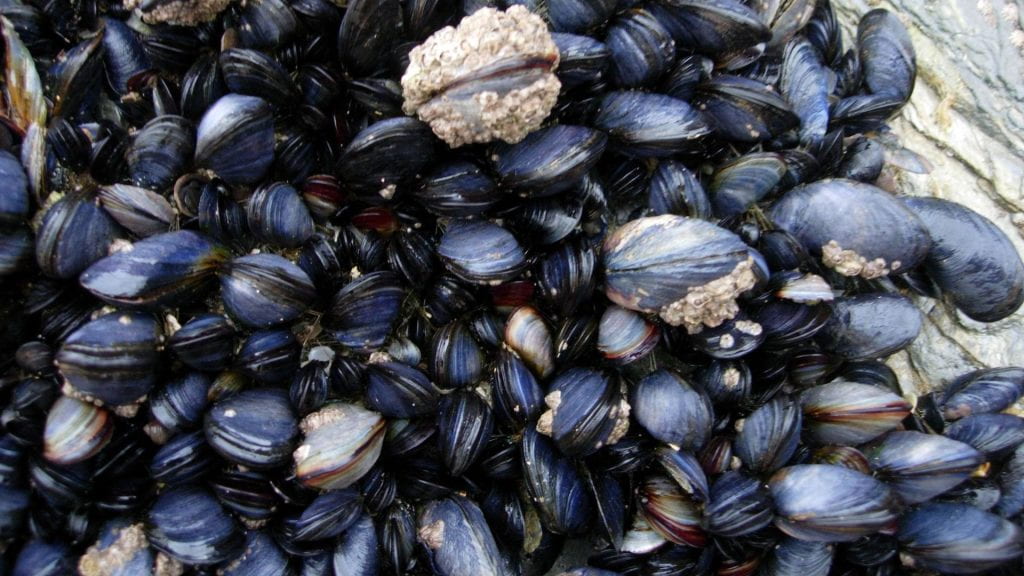
How can you not love a bivalve? I certainly spent seaside holidays picking long, thin razor shells out of the sand on the beach, marvelling at their sharp edges and brown and cream patterned growth lines. I still love clambering over rocky shorelines thick with the blue-black ovals of mussels, encrusted with limpets and rough barnacles, layered with salty strands of seaweed.
Bivalves are a keystone part of a rich ocean fauna, interlocked with the ecology of the marine environment and intertwined with lives of both ancestral and modern humans. Seafood, and particularly shellfish such as mussels, oysters, cockles, scallops and clams have long been part of the human diet. The European market for mussels alone topped 600,000 kg last year (FAO.org), the majority of which are consumed in France, Spain and Italy. Just take a moment to imagine the delicious fragrance of a seafood paella, and you will appreciate why they are so popular. Unfortunately, the future of shellfish is becoming more uncertain as the climate heats up. The days when oysters are used to fire the passions of young lovers, or indeed for lovers to gift each other nacre jewellery or pearls, may be coming to an end. Climate change is likely to lead to a scarcity of oysters and an inability for them to thrive, meaning much smaller individuals, which will make such tokens harder to obtain, more expensive or simply not available anymore.
Aside from being a food source, bivalves are an essential part of the ecosystem in both marine and freshwater habitats. One important task that bivalves do is to filter the water, collecting particles of microalgae, phytoplankton, bacteria and silt. The indigestible particles are packaged with mucus and excreted as a sandy deposit that sinks to the sea floor. In this way, bivalves help to clean murky, turbid water. Some bivalves do this at an incredible rate; green mussels (Perna analiculus) or sea scallops (Placopecten magellanicus) can filter in excess of 10 gallons of water every day. Removing and digesting the algae reduces the number of algal blooms that occur, and sticking sediment particles together so they sink, clears the water. This allows light to penetrate deeper into the ocean, benefitting photosynthetic organisms attached to the seabed.
The structure of the seabed is altered by the presence of bivalves. Some bivalves, such as Venus clams (Veneridae) bury themselves in soft sediments, helping to stabilise the sand. Others attach themselves to rocks using strong root-like threads. Reefs are reinforced by encrusting bivalves, which help to reduce shoreline erosion. This feature is becoming more important as the frequency and intensity of severe weather events is set to increase.
The shells of bivalves are made from either calcite or aragonite, which are different forms of calcium carbonate. The two forms are found in different species and at different stages of the life cycle. They have slightly different chemical properties but they both contain carbon in the form of carbonate, which molluscs extract from seawater. When the shellfish die, the shells drift to the ocean floor to begin the transition into rock such as limestones, ultimately locking carbon away and becoming an important carbon sink. Increasing carbon dioxide in the atmosphere means more carbon dioxide is dissolving in the oceans. Although this might seem like a bonus for the shell-building fauna, the carbon dioxide forms a weak solution of carbonic acid, and this is altering the pH of seawater. Acid reacts with carbonate, dissolving it, so that shelly sea creatures have to work harder to build and maintain their shells.
The complexity of reefs and other underwater habitats is enhanced by bivalves, not just with structural strength, but with complex architecture, which provides niches, refuges and points of attachment for other species. Plenty of creatures apart from humans enjoy munching on bivalves. Squid and octopods can prise the hinged shells apart using the suckers on their tentacles to get at the tasty meat inside. Bivalves also contribute to the food web by spawning large volumes of eggs and larvae. These drift on the ocean currents, providing an essential food source for pelagic fish and other hunters, such as baleen whales.
Having convinced you that bivalves are amazing, what does the future hold for hinged molluscs? Many studies have looked at how different conditions affect bivalves, with some coming to positive, and some to negative conclusions. Cherry picking the answer you want does not necessarily reflect the overall trend and can be quite misleading. One way that scientists use to get an overview of multiple studies is to carry out a meta-analysis. This is a way of combining all the studies to give a statistical probability to each value being tested.
We gathered data on how well bivalves grow under different conditions predicted to change by climate change models. Growth rate can be altered by temperature, pH, oxygen availability and salinity. Ocean temperature is increasing, and this will affect the metabolism of cold-blooded organisms, who rely on the external environment for internal temperature regulation. The pH of the oceans is becoming more acidic, causing the thinning of shells in some shelled sea creatures.
Areas of the ocean are becoming periodically, or permanently short of oxygen. This is happening in two ways. There are widespread dead zones spreading out from the estuaries of major rivers (e.g the Ganges or Mississippi) where nitrates and other pollutants are causing eutrophication, which uses up all the dissolved oxygen. Across water courses as a whole, less oxygen is present in water at higher temperatures because oxygen doesn’t dissolve as well in warm as opposed to cold water. Recent summer heat-waves have left a raft of dead, floating, aquatic organisms, both in marine settings and in inland lakes and rivers. Last summer I caught the fire-brigade pumping air into a local fishing pond, trying, mostly unsuccessfully, to prevent the fish from suffocating.
The last climate stressor that we included in our meta-analysis was salinity. As the planet warms, leading to the melting of ice-caps and glaciers, the sea level will rise with the influx of fresh water. This will alter the salinity, especially in the areas of melt-water run-off around coasts where most species of bivalves tend to live. We wanted to see if salinity changes would be problematic for bivalves, and how that would interact with the other climatic changes. One of the interesting things about meta-analyses is that the effect not only of individual stressors can be evaluated, but also the effect of the interaction of stressors. Do they combine to become more than the sum of their parts, or do they counteract each other to have an overall negligible effect?
What we found was that each of the environmental stressors individually reduced bivalve growth, but that combinations of stressors – such as a temperature increase coupled with an increase in acidity – acted together to reduce growth in a more pronounced way. If climate changes in the way that most models are predicting, then they are also predicting fewer, smaller bivalves that take longer to mature. This may disproportionally affect low-income, island nations, such as the Maldives, where a large proportion of the diet is sourced directly from the sea. For the fishing industry, this means sustainable harvesting limits will need to be adjusted over time to allow time for bivalves to grow to maturity.
This is particularly pertinent because the types of bivalves that have been studied are nearly all either commercial or easy-to-collect reef-building species. They come predominately from the northern hemisphere, and there is a distinct lack of studies on African and tropical species. There are over 100 families of bivalves, of which just 18 have had quantitative growth studies carried out. In the studies we used, 81% of them were on just four families: oysters (Ostreidae), mussels (Mytilidae), scallops (Pectinidae) and Venus clams (Veneridae). There are an awful lot of families we know nothing about, and it isn’t necessarily true that how one species responds informs us accurately about what another species might do. Temperature, for example, really slows down the growth of oysters, scallops and mussels, but can increase the growth of Venus clams and pen shells (Pinnidae). I can see you throwing your hands in the air and asking “Why??”
In this case, the answer seems to lie in the habitat or mode of life that the bivalve inhabits. The families that grow faster in warm waters are the type that bury themselves deep in the soft sand or mud of the seabed. This seems to act as a protective buffer against temperature changes, whereas bivalves attached to the surface are exposed to temperature extremes and so they show reduced growth.
The data became even more interesting when we looked at how different life stages responded to environmental stressors. Nearly all (84%) of the studies we could include in our meta-analysis had been carried out on eggs/larvae or juveniles. This of course, makes perfect sense if you are studying growth, as young organisms do an awful lot more growing than adults. It does, however, leave a hole in the data, and that can lead to biased conclusions.
Very young bivalves, which are generally a free-living part of marine plankton, grow less well in warm, acidic or low oxygen conditions. Low salinity doesn’t seem to be an issue. Adults, on the other hand, can tolerate warm, acidic or low oxygen conditions singly, but struggle when these occur in combination. Adults are also strongly affected by low salinity (in the very few studies that have tested this). Again, this makes reasonable sense. Adults are fixed to whichever rock they settled on, and so survival depends far more on metabolic tolerance to environmental extremes. Mobile, free-swimming larval forms have a greater ability to move away from uncomfortable conditions, searching for somewhere they can flourish.
However, larval vulnerability indicates that in the future bivalve populations (as opposed to individuals) will grow more slowly and may suffer from recruitment and settlement problems. It may be difficult, slow or impossible for bivalve colonies to regenerate after disturbance or harvesting, leading to major population crashes.
Climate change is going to pose some challenges to the populations of bivalves. Bivalves supply the seafood industry, filter our water, stabilise our shorelines and produce planktonic larvae, which bolsters the ocean food web. Minimising the effects of climate change will help to protect this keystone fauna and enable them to continue to form such an essential part of the natural world. I hope my children’s children can still delight in finding ropes of mussels and living pearls.
————————————
This blog is written by Rachel Kruft Welton. With thanks to George Hoppit for proof-reading and suggestions. Read more about their research.

